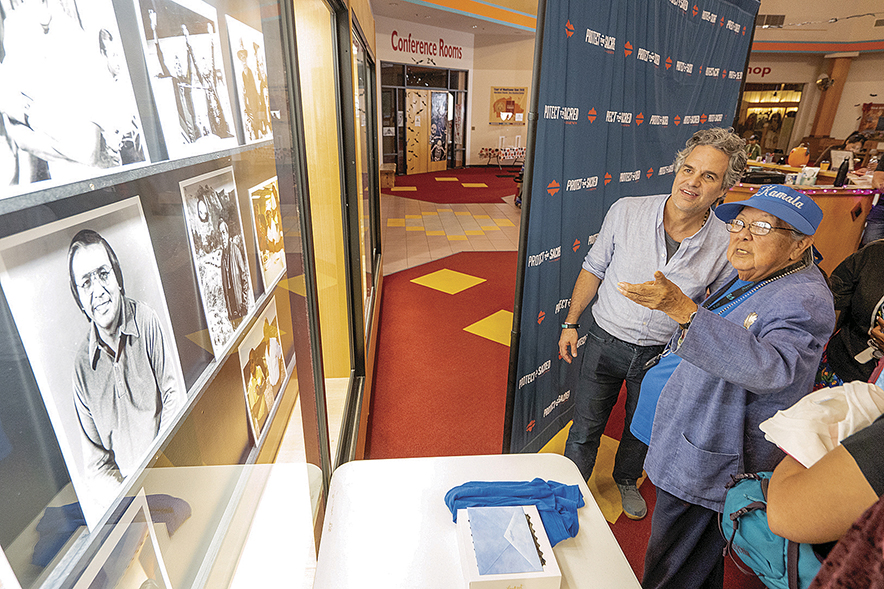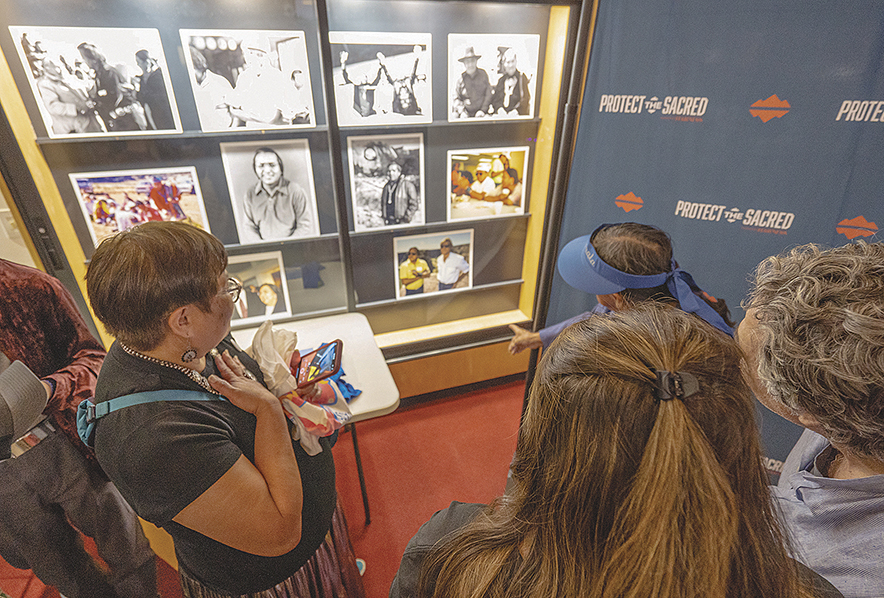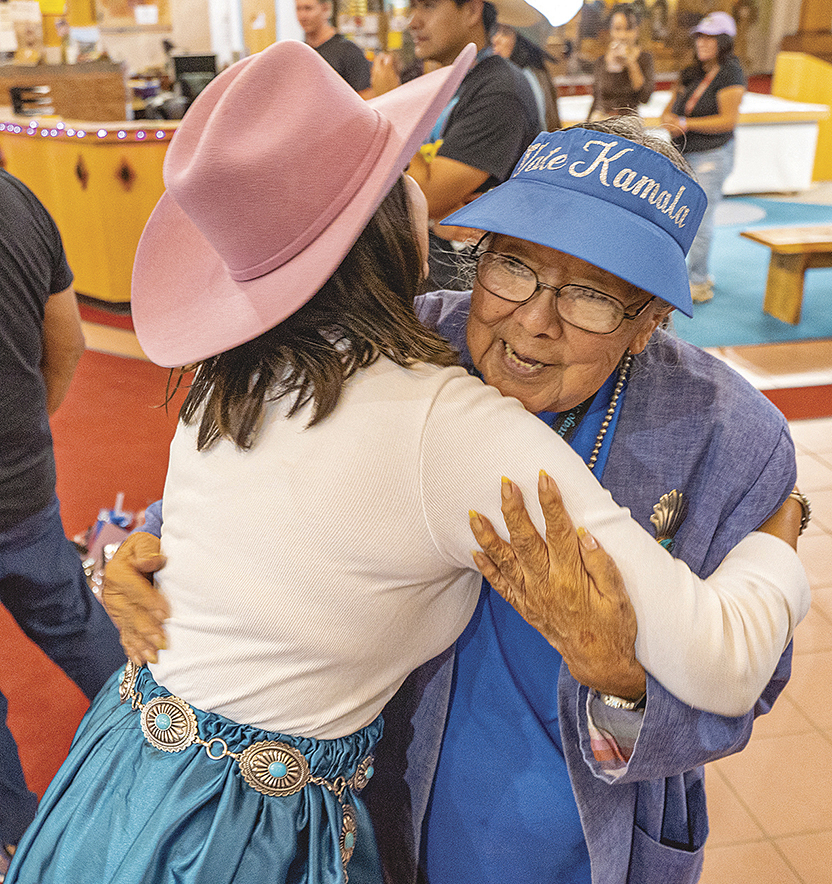
‘Pathway to empowerment’: Remembering Peterson Zah: a legacy of leadership and advocacy

Special to the Times | Donovan Quintero
Rosalind Zah shows Mark Ruffalo photos of her late husband, former Chairman and Navajo Nation President Peterson Zah, on Saturday evening at the Navajo Nation Museum in Window Rock. Ruffalo is an actor, director, and advocate for climate justice and renewable energy.
By Donovan Quintero
Special to the Times
Editor’s note: The late Peterson Zah, the one and only Navajo chairman and president, died March 7, 2023.
WINDOW ROCK – Peterson Zah, a revered figure in the Navajo Nation, dedicated his life to influencing hundreds of young Navajo people, who did not incline toward politics, to think deeply of the future of the Navajo Nation through the power of their votes.
His wife, Rosalind Zah, expressed profound pride in her husband’s longstanding commitment to education and advocacy for Indigenous peoples.
In the heart of the Navajo Nation, the influence of Zah, the first president of the Navajo Nation, endures through the transformative efforts he and his wife, Rosalind, championed.

Special to the Times | Donovan Quintero
Rosalind Zah, second right in blue cap, shows Mark Ruffalo, right, photos of her late husband, former Chairman and Navajo Nation President Peterson Zah, on Saturday evening at the Navajo Nation Museum in Window Rock.
On Saturday, at the Navajo Nation Museum, during the Walk to the Polls event, Rosalind spoke of her late husband and how his unwavering commitment to education and community development left an indelible mark on the Navajo people, inspiring future generations to pursue knowledge and leadership.
His role models weren’t necessarily global leaders like Martin Luther King—it was his mother, Rosalind said.
“I believe that because that’s what he drew everything, all his ideas; if he ran into a problem, the first person he went to talk to was his mother, and she would talk to her parents,” she said on Saturday night in Window Rock.
He also sought the advice and guidance of Navajo traditional practitioners, she added.
The president’s early life
Rosalind Zah recalls her husband’s early life, a journey shaped by a passion for justice and advocacy.
Raised in the Navajo Nation, Pete, as he was affectionately known, dedicated himself to understanding the complexities of governance and legal systems. His educational pursuits led him to become deeply involved with the Democratic Party, where he gained valuable experience that would later benefit his community.
Zah’s passion for education was deeply rooted in his background. Born in 1937 and raised in Low Mountain, Arizona, situated in the heart of the Navajo Reservation. He left home in 1953 to attend the Phoenix Indian School. His educational journey continued at Phoenix Community College and ultimately at Arizona State University, where he earned a bachelor’s degree in education in 1963.
From 1963 to 1964, Zah began his professional journey as a journeyman carpenter with the Arizona Vocational Education Department in Phoenix, where he instructed adults in employable skills. Following this role, he joined the domestic Peace Corps known as Volunteers in Service to America, or VISTA. He then served as the field coordinator of a training center at Arizona State University in Tempe from 1965 to 1967, playing a role in community education and development.
Perhaps it was seeing for himself that only two Navajo teachers were teaching Navajo children at the time, that may have been the catalyst that would shape Pete’s choices that would later catapult him into politics, but Rosalind said he came home one day upset, telling her only two Navajo teachers taught at the school besides himself.
“He came back, and he said, ‘They don’t have any Navajo teachers.’ I go, ‘What?’ He says, ‘They don’t have any Navajo teachers. They only have two in the system.’ And that was the Jackson twins, Jack (Jackson) and Dean (Jackson). He said the rest of the Navajo staff were the bus drivers, cooks, janitors; and that’s the only jobs they had,” Rosalind recalled. “And here we are in the capital of the Navajo Nation, and there’s nobody in this school teaching anything. And he was so upset.”
All-Navajo school board
Zah’s influence in education was solidified when he was elected to the first all-Navajo school board at Window Rock in 1972, becoming its president in 1973. He implemented significant changes, such as hiring more Navajo teachers, incorporating a Navajo curriculum, and developing textbooks that reflected tribal history and culture. Zah championed the idea that the Navajo language should be taught across all subjects, believing it was essential for preserving cultural identity, especially in subjects like science and math where concepts often lack direct translations. Under Public Law 93-638, Zah’s initiatives contributed to the flourishing of contract schools governed by local community members under the Navajo Tribal Council.
At the time, boarding schools were the U.S. government’s main priority in providing an education for Native students. Religious-based schools that primarily focused on the Christian faith also dominated educating Navajo children before public schools became the primary means to educate children in the Navajo Nation.
The couple’s groundbreaking work in education is perhaps one of their most significant legacies. Recognizing the critical need for quality education within the Navajo Nation, Pete and Roz set out to establish public schools accessible to all children.
“Education was at the core of his vision,” Rosalind reflects. “He believed that with education, our children could break the cycle of poverty and inequality.”
Their efforts not only improved access to education but also emphasized the importance of incorporating Navajo culture and language into the curriculum.
Reshaping educational landscape
Pete, she said, played a pivotal role in reshaping the educational landscape of the Navajo Nation. He advocated for policies that would empower young Navajos to pursue higher education, believing that a well-educated youth would be the key to a prosperous future. Under his leadership, numerous scholarship programs were initiated, aimed at encouraging students to dream big and achieve their educational goals.

Special to the Times | Donovan Quintero
Rosalind Zah hugs Allie Redhorse Young, who formed a walk to highlight the importance of voting, on Saturday night at the Navajo Nation Museum in Window Rock.
In 1987, Zah expanded his efforts to support Navajo youth by engaging in fundraising for scholarships through the Navajo Education and Scholarship Foundation, which helped many impoverished students access education. Additionally, he founded the Native American Consulting Services in 1989 to seek congressional support for building new schools on the reservation. Zah also held the position of director at the western regional office of the Save the Children Federation from 1989 to 1990, further emphasizing his dedication to improving educational opportunities for Navajo children.
“He would always say that education is the pathway to empowerment,” Rosalind remembers.
Pete’s respect for traditional Navajo culture was as profound as his commitment to education. He understood that cultural identity was essential to the community’s strength and resilience. This belief extended beyond the classroom; it informed his interactions with global figures, including a memorable meeting with the 14th Dalai Lama in April 1991.
“When we met the Dalai Lama, when he came to the southwest. And the Dalai Lama said to his group — and he told us that himself — the Dalai Lama, he says, ‘I want to meet with all the Native leaders in the southwest.’
“So, Pete, of course, he said, ‘OK, tell me about the Dalai Lama. I say, ‘In the world, three million or five million people believe he’s their god on earth. That is who he is.’ And he said, ‘Oh, really?’ I said, ‘Yeah. And that he lives way in the middle of nowhere, on top of the hill somewhere,’” Rosalind recalled of their preparation before meeting the Dalai Lama.
To her astonishment, when the two met, she couldn’t help but notice how similarly they spoke of the same issues.
“They sat down together, and they talked about people, they talked about all kinds of things, and I just listened. I just couldn’t believe it, and they were saying the same thing to each other,” she said. “And I thought, ‘Oh my gosh, this is incredible.’”
The two met again at the Parliament of the World’s Religions in Chicago, Illinois, in 2021. Rosalind said the leaders’ discussion focused on the shared values of compassion, service, and the significance of cultural preservation.
Power in young people
Jaynie Parrish, who also attended the vote awareness event, attributes President Zah as being the reason why she became involved in politics.
“He knew how young people were good resources, they were power. And if he could get them to be the lawyers, doctors, the nurses, that’s how we rebuild our nation. And so, he’s always done that,” said Parrish.
She was majoring in interdisciplinary studies at the time when the former chairman told her she should go to ASU’s law school for free because he helped set it up.
“But I ended up getting into politics and campaigns, and he was the one who called me home in 2020 and said, ‘We need you at home. We need you to organize Navajo voters,’” Parrish shared. “So that’s why, and I’m still here doing it. I’m not the only one. Again, there’s so many of us where they’ve attested to say, ‘He put me here,’ and even I didn’t know I was going to be here.”
Beyond educational reform
Zah’s legacy extends far beyond educational reform. He cultivated a sense of leadership within Navajo communities, engaging individuals at all levels to participate in decision-making processes. Pete often encouraged young people to take active roles in community service and local governance, fostering a spirit of involvement that remains vital today.
“He taught us that leadership is not just about holding a title; it’s about serving your community and uplifting others,” Rosalind emphasizes.
Zah’s commitment to legal services was also evident during his tenure as executive director of the nonprofit organization DNA—Diné be’iiná Náhiiłna be ‘Agha’diit’ahii—from 1967 to 1981. DNA was chartered by the state of Arizona and focused on providing legal assistance aimed at contributing to the economic revitalization of the Navajo people. Under Zah’s leadership, the organization worked diligently to address the unique legal needs of the community.
As the Navajo Nation continues to navigate the challenges of the modern world, Rosalind said the influence of her late husband remains a guiding light. His contributions have not only transformed the educational landscape but have also inspired generations to embrace their heritage and invest in the future of their community.
“Pete’s legacy is alive in the hearts of those he touched,” Rosalind states with pride. “It’s up to us to carry it forward.”








 Highway 264,
Highway 264, I-40, WB @ Winslow
I-40, WB @ Winslow